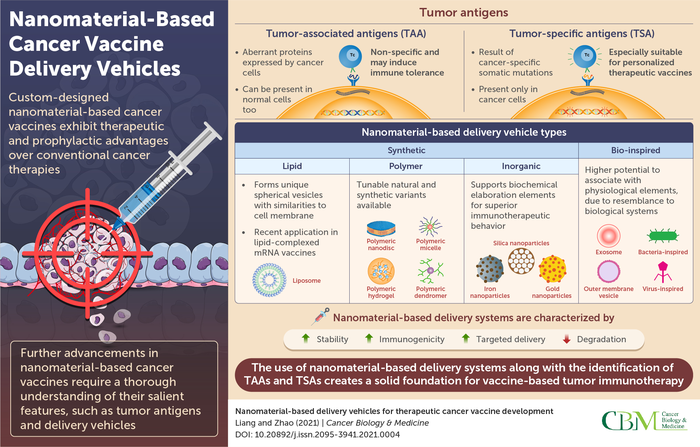In recent years, remarkablee developments within the field of cancer research have directed people to the next level in cancer therapy, including vaccines for cancer. But direct inoculation of these vaccines in the affected individuals has often met with failure to deliver the required anti-tumor effects.
 Nanomaterial-based delivery strategies are being investigated to achieve efficient and targeted delivery of cancer vaccines to the tumor site. Image Credit: Cancer Biology & Medicine.
Nanomaterial-based delivery strategies are being investigated to achieve efficient and targeted delivery of cancer vaccines to the tumor site. Image Credit: Cancer Biology & Medicine.
Lack of targeted delivery to the tumor cells is one of the reasons for this failure. Therefore, researchers are working on developing suitable cancer vaccine delivery vehicles. This is regarded as the next phase of cancer research.
Nanomaterial-based cancer vaccine delivery vehicles are under development for many years now. Although the research has witnessed many improvements, there is more work to be performed before it could be clinically available for use. Consolidation of all available findings related to cancer vaccine delivery vehicles is required for the success of the research.
Dr Jie Liang and Dr Xiao Zhao, from the Chinese Academy of Sciences’ (CAS) Key Laboratory for Biomedical Effects of Nanomaterials and Nanosafety & CAS Center for Excellence in Nanoscience, National Center for Nanoscience and Technology of China, and University of Chinese Academy of Sciences, are working with the same motive.
Accordingly, they have presented a detailed review of several types, advantages, and disadvantages of the delivery vehicles. Their review also envelops the developments made in tumor antigen research.
The study was published in the journal Cancer biology & Medicine, on May 15th, 2021. The researchers have segregated the delivery vehicles into four primary categories: polymer-based, lipid-based, inorganics-based, and bio-inspired vehicles.
Lipid-based vehicles containing liposomes have the potential to obtain a stable spherical shape following encapsulation of the antigen. They are beneficial because of their similarity to the cell membrane, which enables an enhanced uptake of the vaccine into the focused area. Recently, mRNA vaccines have been developed using lipid-based vehicles.
Polymer-based vehicles offer additional choices, as natural or synthetic sourced delivery vehicles capable of being tailored to the essential biochemical properties. Examples of synthetic polymer-based vehicles are poly (lactic-co-glycolic acid) and polycaprolactone. Peptide and glycan nano/microcarriers are few examples of natural polymer-based vehicles.
Vaccines developed using inorganic-based vehicles have assisted in intensifying the biochemical components present in the immune system. This increases the anti-cancer effect. Some examples of these are iron oxide, gold, and silica frameworks.
In general, inorganic-based delivery strategies should be used to ensure the enrichment and retention time of antigens in lymphatic circulation, where immune effectiveness is induced and then increased.
Dr Xiao Zhao, Study Corresponding Author, Chinese Academy of Sciences
The other suitable ones are bio-inspired delivery vehicles that have the ability to reflect the body’s cells or successful invaders like viruses or bacteria to realize safety and specific cancer vaccine delivery. Furthermore, these vehicles are capable of serving as adjuvants and improve immune activation.
But the use of each of these vaccine delivery vehicles has been restricted by drawbacks like biodegradability, toxicity, and hampered immune responses, specifically when utilized individually. Hence, the researchers present a combination of four types of NCV to improve the targeted anti-cancer activity.
Also, the team emphasized the necessity to assess the success of targeting specific tumor antigens, particularly via in silico methods, before loading them on cancer vaccine delivery endeavors.
On the whole, the study authors are expecting that their review would inspire other researchers to rectify the defects of existing cancer delivery vehicles, thus quantifying an effective tumor-targeted vaccine delivery system, with the needed prophylactic and therapeutic advantages.
We summarize the development of preclinical therapeutic cancer vaccines and the advancements of nanomaterial-based delivery vehicles for cancer immunotherapies, which provide the basis for a personalized vaccine delivery platform.
Dr Jie Liang, Chinese Academy of Sciences
“Moreover, we review the existing challenges and future perspectives of nanomaterial-based personalized vaccines for novel tumor immunotherapies,” added Dr Liang.
Journal Reference:
Liang, J & Zhao, X (2021) Nanomaterial-based delivery vehicles for therapeutic cancer vaccine development. Cancer Biology & Medicine. doi.org/10.20892/j.issn.2095-3941.2021.0004.